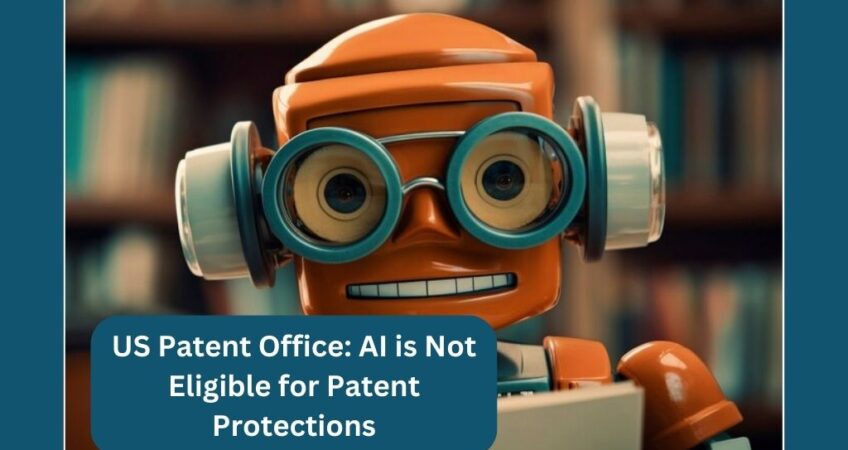Introduction
In February 2024, the US Patent and Trademark Office (USPTO) issued guidance on the patentability of artificial intelligence inventions. This guideline, published in the Federal Register on Tuesday, seeks to clarify the patent application process as AI plays an increasingly important role in innovation across all technology areas.
The guidance was published in response to President Joe Biden’s executive order seeking clarity on the patentability of AI-assisted technologies.
The major point made in the guidance is that AI-assisted ideas are not always unpatentable. Based on the concept that patents are intended to incentivize and reward human innovation, it emphasizes that inventorship analysis should centre on human contributions.
Decision By USPTO: AI is Not Eligible for Patent Protections
In a decision that underlines the evolving relationship between artificial intelligence (AI) and the legal framework, the United States Patent and Trademark Office (USPTO) announced today that, contrary to some expectations, AI systems will not be eligible to acquire formal patent protections. The announcement, delivered through official guidance, reiterates that only “natural humans” can be granted patents, citing legal precedents and the fundamental principle that patents are designed to reward human ingenuity.
While yet to be formally enshrined in the federal register, the guidance clarified that AI-assisted inventions are not automatically disqualified from patent eligibility. However, the innovative contributions made by AI systems must be attributed to at least one human inventor. The USPTO emphasized the necessity for human involvement in the inventive process, stipulating that inventors must demonstrate a “significant contribution” to the innovation to qualify for patent protection.
The decision highlights the intricate legal landscape surrounding AI and its role in innovation. While AI systems can generate groundbreaking ideas and solutions, they lack the legal status of “individuals” and thus cannot be recognized as inventors under current statutes. This distinction underscores the ongoing debate over the legal personhood of AI entities and their rights and responsibilities within the legal framework.
Logical Reason Behind USPTO’s Decision
The USPTO’s stance reflects a cautious approach to integrating AI into legal frameworks. While acknowledging the potential of AI technologies, the guidance underscores the need to align patent policies with established legal principles. The agency clarified that its decision is not an attempt to regulate AI or its capabilities but rather an application of existing laws to emerging technologies.
Notably, the guidance leaves room for legislative changes that could redefine the status of AI in intellectual property law. Should Congress enact legislation recognizing AI as eligible inventors, the USPTO would adapt its policies accordingly. Until then, however, AI remains classified as a tool rather than a legal entity, with human inventors retaining primary responsibility for innovation and patent eligibility.
The USPTO’s announcement marks a significant milestone in the ongoing discourse surrounding AI and its place within the legal system. As technology advances, questions of legal personhood and responsibility in the age of AI are likely to remain subjects of debate and scrutiny.
History Behind Developing the Decision
In August 2019, the United States Patent and Trademark Office (USPTO) promulgated a call for public commentary on patenting Artificial Intelligence (AI) technologies. Within this solicitation, the USPTO delineated several pertinent policy inquiries, chief among them being the matter of inventorship concerning AI inventions. Specifically, the USPTO sought elucidation on the multifarious ways in which a natural person may contribute to the conception of an AI invention and further deliberated upon whether extant inventorship statutes and regulations necessitated revision to accommodate contributions originating from entities beyond natural persons.
In October 2020, the USPTO issued a comprehensive report entitled “Public Views on Artificial Intelligence and Intellectual Property Policy,” which meticulously analyzed the feedback obtained from stakeholders in response to the inquiries outlined in the August 2019 notice.
Regarding the intricate issue of inventorship, divergent viewpoints emerged from the comments tendered. While some contended that prevailing AI lacks the capability to invent absent human interaction and consequently opined that existing inventorship laws suffice for handling inventorship scenarios involving AI technologies, others proffered a contrasting perspective. This latter viewpoint posited that AI could contribute to idea generation through various means, potentially resulting in the generation of patentable inventions devoid of human creative input.
The Decision Making Stage
Amidst the USPTO’s deliberations concerning the contours of inventorship legislation vis-à-vis AI-generated inventions, the office encountered applications asserting that the AI machine served as the inventor. On April 22, 2020, the USPTO issued two opinions rejecting petitions to designate the Device for Autonomous Bootstrapping of Unified Sentience (DABUS), an AI system, as the inventor. In justifying its determination, the USPTO underscored the prevailing understanding that inventorship within the United States confines itself to natural persons as delineated by extant patent statutes.
Subsequently, on September 2, 2021, the United States District Court for the Eastern District of Virginia upheld the USPTO’s ruling, further cementing the jurisprudential stance on AI inventorship. However, notwithstanding the Thaler ruling, and given the present state of AI and machine learning technologies, ambiguity persists concerning AI inventorship. This uncertainty assumes a heightened immediacy on whether AI is not eligible for patent protection, particularly machine learning systems, progressively augment their contributions to innovation. Consequently, in instances where these technologies contribute substantially to invention creation, the adequacy of existing legal frameworks in affording patent protection for such inventions remains unresolved.
Conclusion
The US Patent and Trademark Office (USPTO) is critical in rewarding and protecting innovation, especially AI-enabled innovation, to maintain the United States’ sustained leadership in AI and other emerging technologies (ET). In June 2022, the USPTO announced the establishment of the AI/ET Partnership, which will bring stakeholders together through a series of engagements to share ideas, feedback, experiences, and insights on the junction of intellectual property and AI/ET. To complement the AI/ET Partnership initiatives, the USPTO invites stakeholder feedback on the current state of AI technology and any inventorship difficulties that may develop as such technologies advance, particularly as AI plays a larger role in the innovation process.

